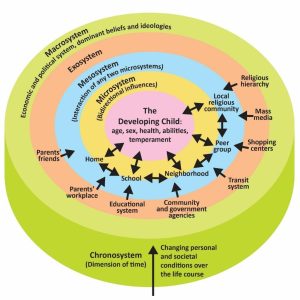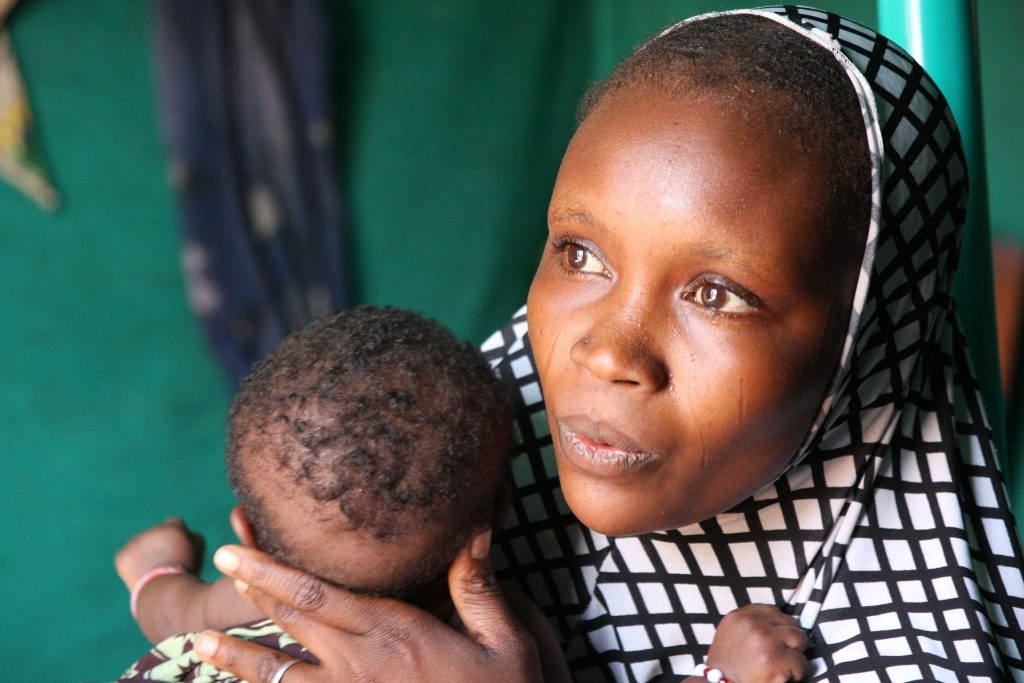Bioecological Systems Theory

One of the key theories that explains influences on individuals and their families is Bronfenbrenner’s bioecological systems theory. A basic tenet of Bronfenbrenner’s bioecological systems theory (Bronfenbrenner & Morris, 2006) is that child and youth development are influenced by many different contexts, settings, or ecologies. Examples include family, peers, schools, communities, sociocultural belief systems, policy regimes, and the economy. At the center of this theory is the child. As we move in and out of the circles, we categorize the external influences that impact the child’s development. Those circles impact each other. They shift and change in society and in the overall influence on the child.
Table 2.1: Bronfenbrenner’s bioecological systems theory
| Name | Description |
| Microsystem | Microsystems impact a child directly. These are the people with whom the child interacts such as parents, peers, and teachers. The relationship between individuals and those around them need to be considered. |
| Mesosystem | Mesosystems are interactions between those surrounding the individual. The relationship between parents and schools, for example, will indirectly affect the child. |
| Exosystem | Larger institutions such as the mass media or the healthcare system are referred to as the exosystem. These have an impact on families and peers and schools who operate under policies and regulations found in these institutions. |
| Macrosystem | We find cultural values and beliefs at the level of macrosystems. These larger ideals and expectations inform institutions that will ultimately impact the individual. |
| Chronosystem | All of this happens in an historical context referred to as the chronosystem. Cultural values change over time, as do policies of educational institutions or governments in certain political climates. Development occurs at a point in time. |
Bronfenbrenner’s bioecological systems theory looked at patterns of development across time. It also considered the interactions between the development of the child and the environment. The implications of this model include the social and political policies and practices affecting children, families, and parenting. The bioecological systems theory serves as a visual organizer to both summarize and unpack key concepts and themes as they relate to individual development, teaching and learning, and educational practices. The goal of learning the bioecological systems theory is to understand the theoretical and research foundations that inform the work in supporting students’ well-being, teaching and learning, and identifying and using other factors/resources such as parents, family, peers, to provide positive influence on students’ learning and development.
Case Study (A)

The human ecology framework extends Bronfenbrenner’s model. As an example, a family seeking refugee resettlement might be influenced by the following systems (Lang):
- Biophysical environment: Were members of the family injured as they fled persecution?
- Microsystem: Was there parental conflict from the stress of fleeing persecution?
- Mesosystem: Is the family working with teachers and other school personnel who do not understand the complexities of refugee resettlement, or the home language of the family, or the cultural traditions of the family?
- Exosystem: How have local leaders responded in ensuring that the family has support services and cultural experiences that welcome and include them into the community?
- Macrosystem: Is the family experiencing discrimination or racism in the community of resettlement?
- Chronosystem: How has the community of resettlement changed over time in response to the resettlement of multiple refugee families?
Case Study (B)
Reading about the Bioecological Systems Theory, I can think of a time in my life that shows each system impacting my childhood. Halfway through my fifth grade year, my parents informed me that we would travel overseas to live in Izmir, Turkey for two years. Even though my dad was in the military and we were used to moving a lot, we were surprised by this news. I didn’t have a ton of time to prepare mentally and emotionally. We had a long sit down at the dinner table talking about this huge change in our life. I was so upset about leaving my friends and dog behind. For me, that resonates with microsystems.
I experienced a lot of issues with being bullied while living in Turkey. I was the new kid, coming in with my southern U.S. accent. I was physically attacked by one girl in the bathroom at school which sent me to a local Turkish hospital. At the time, we were not living on a military base, but in the community of Izmir itself. My parents and my dad’s commanding officer had to have a giant sit down meeting with the school. At the time, I felt like it was just making everything worse but really, I just wanted to go home back to my friends. This was part of my mesosystem.
I developed panic attacks from the trauma of moving, of being bullied, and of feeling isolated. I was in and out of the hospital until I learned how to self soothe and control my anxiety on my own, but needing to go to the hospital from panic attacks was enough to stress me out and send me back time and time again. The cultural divide was wide. In Izmir, there was not a military base. Our family lived in Izmir. Americans were seen as aggressors. I was constantly harassed in the streets due to the significant cultural differences. I wore tank tops and shorts, while most women from Turkey dressed in long scarfs, head coverings, and long skirts. This was really hard for me as a fifth grader. I didn’t fully understand. This was part of my exosystem and macrosystem.
Coming back to the United States was difficult. I began to understand that cultural differences mattered and that the United States was seen as an aggressor in other parts of the world. I was able to have first-hand experience of cultures and beliefs outside of what I grew up in. I gained a deeper understanding of my own self and for how I interact with folks from parts of the world outside of the U.S. This was part of my chronosystem.
Bronfenbrenner’s bioecological systems theory and the human ecology framework assume that families are intentional in their decision-making and that they work toward
- biological sustenance,
- economic maintenance, and
- psychosocial function.
As patterns in the social environment threaten family’s quality of life in these three areas, the system will be more and more likely to seek change. Those threats create non-supportive and exclusive communities that work against the families’ participation and inclusion in schools and communities.
Pause to Reflect!
Discuss the following questions.
- Think of yourself at a particular time in your childhood (e.g., age 10). Describe how each system in the bioecological systems theory model directly impacted your development. Identify your influencers in each system.
- Identify two specific community resources that are available to children and families in your community that address each system in the bioecological systems theory model. For each resource, provide the address, phone number, and web site. Why does each resource connect to the specific system level?
Media Attributions
- Bronfenbrenner’s ecological systems theory © Ian Joslin is licensed under a CC BY (Attribution) license
- Amina Aboukar, Nigerian refugee from Damassak © EU Civil Protection & Humanitarian Aid is licensed under a CC BY-NC-ND (Attribution NonCommercial NoDerivatives) license

